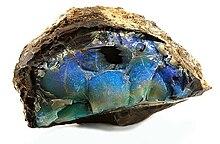| Opal | |
|---|---|
 A rich seam of iridescent opal encased in matrix | |
| General | |
| Category | Mineraloid |
| Formula (repeating unit) | Hydrated silica. SiO2·nH2O |
| IMA symbol | Opl[1] |
| Crystal system | Amorphous[2] |
| Identification | |
| Color | Colorless, white, yellow, red, orange, green, brown, black, blue, pink |
| Crystal habit | Irregular veins, in masses, in nodules |
| Cleavage | None[2] |
| Fracture | Conchoidal to uneven[2] |
| Mohs scale hardness | 5.5–6[2] |
| Luster | Subvitreous to waxy[2] |
| Streak | White |
| Diaphaneity | opaque, translucent, transparent |
| Specific gravity | 2.15+0.08 −0.90[2] |
| Density | 2.09 g/cm3 |
| Polish luster | Vitreous to resinous[2] |
| Optical properties | Single refractive, often anomalous double refractive due to strain[2] |
| Refractive index | 1.450+0.020 −0.080 Mexican opal may read as low as 1.37, but typically reads 1.42–1.43[2] |
| Birefringence | none[2] |
| Pleochroism | None[2] |
| Ultraviolet fluorescence | black or white body color: inert to white to moderate light blue, green, or yellow in long and short wave, may also phosphoresce, common opal: inert to strong green or yellowish green in long and short wave, may phosphoresce; fire opal: inert to moderate greenish brown in long and short wave, may phosphoresce[2] |
| Absorption spectra | green stones: 660 nm, 470 nm cutoff[2] |
| Diagnostic features | darkening upon heating |
| Solubility | hot salt water, bases, methanol, humic acid, hydrofluoric acid |
| References | [3][4] |

Opal is a hydrated amorphous form of silica (SiO2·nH2O); its water content may range from 3% to 21% by weight, but is usually between 6% and 10%. Due to the amorphous chemical structure, it is classified as a mineraloid, unlike crystalline forms of silica, which are considered minerals. It is deposited at a relatively low temperature and may occur in the fissures of almost any kind of rock, being most commonly found with limonite, sandstone, rhyolite, marl, and basalt.
The name opal is believed to be derived from the Sanskrit word upala (उपल), which means 'jewel', and later the Greek derivative opállios (ὀπάλλιος).
There are two broad classes of opal: precious and common. Precious opal displays play-of-color (iridescence); common opal does not.[5] Play-of-color is defined as "a pseudo chromatic optical effect resulting in flashes of colored light from certain minerals, as they are turned in white light."[6] The internal structure of precious opal causes it to diffract light, resulting in play-of-color. Depending on the conditions in which it formed, opal may be transparent, translucent, or opaque, and the background color may be white, black, or nearly any color of the visual spectrum. Black opal is considered the rarest, while white, gray, and green opals are the most common.
- ^ Warr, L.N. (2021). "IMA–CNMNC approved mineral symbols". Mineralogical Magazine. 85 (3): 291–320. Bibcode:2021MinM...85..291W. doi:10.1180/mgm.2021.43. S2CID 235729616.
- ^ a b c d e f g h i j k l m Gemological Institute of America, GIA Gem Reference Guide 1995, ISBN 0-87311-019-6
- ^ "Opal". Webmineral. Archived from the original on 18 October 2011. Retrieved 8 October 2011.
- ^ "Opal". Mindat.org. Archived from the original on 6 October 2011. Retrieved 8 October 2011.
- ^ "Opal Description". Gemological Institute of America. Retrieved 4 June 2018.
- ^ "Glossary: Play of Color". Mindat. Retrieved 4 June 2018.